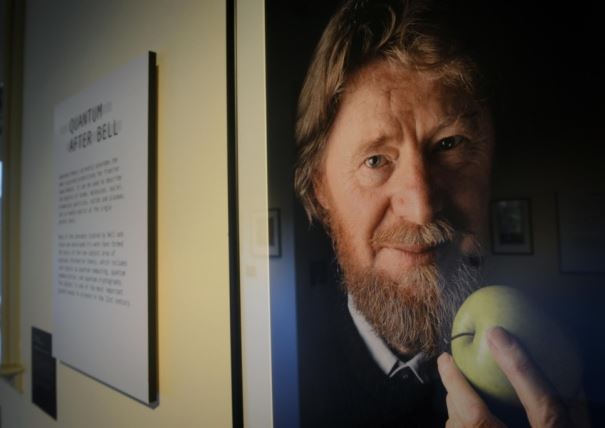The life and legacy of John Stewart Bell 
11 November 2014
A landmark theorem formulated by a Queen’s graduate is currently being celebrated by his alma mater, on the 50th anniversary of its publication. “Action at a Distance: the life and legacy of John Stewart Bell” marks the contribution by the Nobel Prize for Physics nominee, who is widely regarded as one of the most influential scientists of the twentieth century.
Dr Bell formulated a theorem which physicists, philosophers and historians now consider to be one of the most significant developments in quantum theory.
‘Bell’s Theorem’, more formally known as ‘On the Einstein-Podolsky-Rosen paradox’, was first published on November 4, 1964 and resolved a decades-old dispute involving Albert Einstein, which ultimately demonstrated that Einstein’s views on quantum mechanics were incorrect. In simple terms, the Theorem centred on the question of whether particles can somehow ‘communicate’ with each other, even if they are in different places. Einstein is famously said to have mocked such a notion, calling it “spooking action at a distance”.
The Theorem also laid the foundation for a fast-developing area of modern physics – quantum information technology – which is having a revolutionary impact on computing and cryptography with particular application in the financial-services and cyber-security industries.
In addition to the ground-breaking exhibition at the Naughton Gallery at Queen’s other commemorative events to mark the anniversary of ‘Bell’s Theorem’ include the floodlighting of Belfast City Hall, and the naming of a Belfast building after him. There will also be a series of free, public lectures at Queen’s.
 Born into a working-class family in Tate’s Avenue, Belfast in 1928, Bell failed to secure a scholarship to grammar school. He left formal education at 16 to work as a lab technician at Queen’s where his talent was noticed and he was encouraged to resume his studies. He graduated in 1949 with a BSc in Mathematical Physics and later, in 1988 with an honorary Doctor of Science (DSc).
Born into a working-class family in Tate’s Avenue, Belfast in 1928, Bell failed to secure a scholarship to grammar school. He left formal education at 16 to work as a lab technician at Queen’s where his talent was noticed and he was encouraged to resume his studies. He graduated in 1949 with a BSc in Mathematical Physics and later, in 1988 with an honorary Doctor of Science (DSc).
Bell was nominated, and widely believed to be a front-runner for, the Nobel Prize before his sudden death in 1990 of a brain haemorrhage, reportedly without realising he was in the running for the international recognition.
Dubbed one of the top ten physicists of the 20th century by the Institute of Physics, he is considered by some scientists to rank alongside Isaac Newton and Albert Einstein.
Professor Tom Millar, Dean of Engineering and Physical Sciences at Queen’s said: “Bell’s story goes to the heart of the Queen’s experience – it’s the story of how world-class education continues to advance knowledge, change lives and impact the world around us. It is great to see the Northern Ireland scientists of today, whose work is inspired by John Bell, leading the UK's national academic centre for internet security at Queen’s Centre for Secure Information Technologies situated in the Northern Ireland Science Park.”
Professor Mary Daly, President of the Royal Irish Academy, said: “The Royal Irish Academy wants John Bell to be the best-known scientist in Northern Ireland and to be acknowledged as one of the most important scientists in the world.”
The unique exhibition in the Naughton Gallery explores Bell’s life and the artistic response to his legacy by artists from across the world. It includes photographs, objects and papers relating to his work alongside videos exploring his science and legacy and features artistic responses to Bell’s Theorem including one of the most significant, contemporary artworks from Australia – Bell’s Theorem – on show in Europe for the first time.
Exhibition curator Shan McAnena said: “This exhibition combines both Bell the man and Bell the scientist. Although he was a physicist dealing in highly complex theories of quantum mechanics, Bell was also a philosopher, and we have tried to reflect some of that duality in this show.”
Further details on the Naughton Gallery exhibition, which runs until November 30, and the lecture series can be found at www.naughtongallery.org
Media inquiries to Queen’s University Communications Office: Una Bradley (Mon-Wed) on 00 44 (0)28 9097 5320 or Michelle Cassidy (Thurs-Fri) 00 44 (0)28 9097 5310 or email comms.officer@qub.ac.uk
Back to Main News
Top of Page